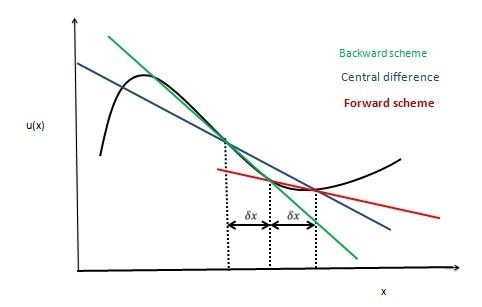 | ||
In applied mathematics, the central differencing scheme is a finite difference method. The finite difference method optimizes the approximation for the differential operator in the central node of the considered patch and provides numerical solutions to differential equations. The central differencing scheme is one of the schemes used to solve the integrated convection-diffusion equation and to calculate the transported property Φ at the e and w faces. The advantages of this method are that it is easy to understand and to implement, at least for simple material relations, and that its convergence rate is faster than some other finite differencing methods, such as forward and backward differencing. The right hand side of the convection-diffusion equation which basically highlights the diffusion terms can be represented using central difference approximation. Thus, in order to simplify the solution and analysis, linear interpolation can be used logically to compute the cell face values for the left hand side of this equation which is nothing but the convective terms. Therefore cell face values of property for a uniform grid can be written as
Contents
- Steady state convection diffusion equation
- Formulation of steady state convection diffusion equation
- Conservativeness
- Boundedness
- Transportiveness
- Accuracy
- Applications of central differencing scheme
- Advantages
- Disadvantages
- References
Steady-state convection diffusion equation
The convection–diffusion equation is a collective representation of both diffusion and convection equations and describes or explains every physical phenomenon involving the two processes: convection and diffusion in transferring of particles, energy or other physical quantities inside a physical system. The convection-diffusion is as follows:
here Г is diffusion coefficient and Φ is the property
Formulation of steady-state convection diffusion equation
Formal integration of steady-state convection–diffusion equation over a control volume gives
This equation represents flux balance in a control volume. The left hand side gives the net convective flux and the right hand side contains the net diffusive flux and the generation or destruction of the property within the control volume.
In the absence of source term equation one becomes
Assuming a control volume and integrating equation 2 over control volume gives:
Integration of equation 3 yields:
It is convenient to define two variables to represent the convective mass flux per unit area and diffusion conductance at cell faces which is as follows :
Assuming
And integrated continuity equation as:
In central differencing scheme we try linear interpolation to compute cell face values for convection terms.
For a uniform grid we can write cell face values of property Φ as
On substituting this into integrated convection – diffusion equation we obtain,
And on rearranging,
Conservativeness
Conservation is ensured in central differencing scheme since overall flux balance is obtained by summing the net flux through each control volume taking into account the boundary fluxes for the control volumes around nodes 1 and 4.
Boundary flux for control volume around node 1 and 4
because
Boundedness
Central differencing scheme satisfies first condition of Boundedness.
Since
Another essential requirement for Boundedness is that all coefficients of the discretised equations should have the same sign (usually all positive). But this is only satisfied when (peclet number)
Transportiveness
It requires that transportiveness changes according to magnitude of peclet number i.e. when pe is zero
Accuracy
The Taylor series truncation error of the central differencing scheme is second order. Central differencing scheme will be accurate only if Pe < 2. Owing to this limitation central differencing is not a suitable discretisation practice for general purpose flow calculations.
